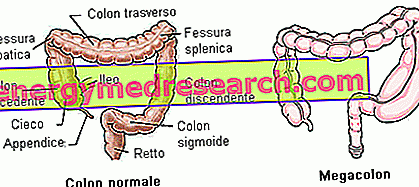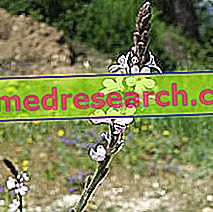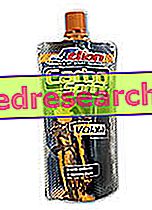Generality
Toxic megacolon is an abnormal gaseous distension of the colon, of acute onset, independent of obstructive processes. The important total or segmental dilation of the colic walls causes symptoms such as swelling and abdominal pain, fever and shock.
Toxic megacolon is a very serious condition and can be lethal when it is not treated with the utmost urgency and adequately. The "toxic" attribute distinguishes it from other non-toxic forms of colic distension, such as congenital (Hirschsprung's disease), idiopathic or pseudo-obstructive (Ogilvie's syndrome). In particular, we talk about toxic megacolon to emphasize the presence of systemic toxicity symptoms (such as mental confusion) due to alterations of electrolytic homeostasis and acid-base balance.

Causes
Disorders associated with Toxic Megacolon
- Chronic inflammatory bowel disease
- Ulcerative rectocolitis
- Crohn's disease
- Infectious colitis
- Salmonella, Shighella, amoebic colitis
- Clostridium difficile (pseudomembranous colitis)
- Cytomegalovirus colitis
- HIV / AIDS
- Cancer chemotherapy
- Ischemic colitis, especially in the elderly
- Complications of diverticular diseases, especially in the elderly
- Stenosing colon tumors, especially in the elderly
- Sepsis, shock states, MOF, etc.
Toxic megacolon is a complication of inflammatory bowel disease. Ulcerative colitis and Crohn's disease are the most common causes of toxic megacolon in Italy and other industrialized countries, while in developing and debilitated patients toxic megacolons due to colonic infectious processes leading to colitis prevail pseudomembranous.
Unlike what happens in a common colitis, in the presence of toxic megacolon the inflammatory process is not limited to the superficial layers of the intestinal walls (mucosa), but goes deeper, also involving the submucosal, muscular and serous tissues. By affecting the nerve endings of the plexuses, the inflammatory process can lead to muscular paralysis of the colon, with arrest of the progression of the enteric content and consequent distension. Due to the increased pressure, local venous and arterial vessels are progressively occluded, facilitating necrotic and perforative processes. Furthermore, the absorption of water and electrolytes through the intestinal mucosa is compromised.
As a mere indication, toxic megacolon complicates from 5 to 10% of cases of ulcerative rectocolitis, while it is rarer among subjects with Crohn's disease. Today, thanks to the advent of new biological drugs that allow better control of inflammation, the onset of toxic megacolon as a complication of ulcerative colitis is becoming increasingly rare. Often, it occurs as an acute initial episode, less frequently during an exacerbation phase and rarely in chronic and continuous forms of ulcerative colitis. More generally, therapeutic and pharmacological advances (eg antibiotic therapies and anti-retroviral drugs) have reduced the incidence of toxic megacolon as a complication of the aforementioned diseases. However, even drugs can be risk factors for the onset of toxic megacolon; this is the case, for example, of prolonged antibiotic therapies not compensated by taking probiotics: such treatment can cause intestinal dysbiosis with selection of resistant strains (Clostridium difficile pseudomembranous colitis, common in hospitals and difficult to treat). Also antidiarrheal, narcotics or anticholinergics - administered for the treatment of ulcerative colitis, of m. of Crohn's or a trivial viral gastroenteritis - they can promote the onset of toxic megacolon, slowing down intestinal peristalsis until it stops.
Symptoms and complications
To learn more: Symptoms Megacolon Toxic
Clinically, the toxic megacolon manifests itself with the typical picture of severe acute colitis, which can sometimes develop dramatically, characterized by symptoms and signs of peritoneal involvement (peritonitis) and systemic toxicity:
- Increasing, localized or widespread Abdominal pain
- Abdominal swelling with significant gaseous distension of intestinal loops
- Abdominal tenderness exacerbated by pressure
- Absence or scarcity of intestinal peristalsis that typically arises after a conspicuous diarrhea with numerous discharges (even 10-15 / day)
- Temperature
- Tachycardia
- Dehydration
- Pallor
- Mental confusion or psychic agitation
The most feared complication of toxic megacolon is intestinal perforation linked to abnormal distension of the colic walls. The extension of the infectious-inflammatory process to the blood can be responsible for sepsis and shock (tachycardia, hypotension, nausea, profuse sweating, confusion).
Diagnosis
In the absence of an improvement in general conditions, the paradoxical and sudden stop of faecal emission in a patient up to a short time before suffering from profuse diarrhea, must always lead to suspect the onset of a toxic megacolon. Another important clinical sign is the critical reduction of abdominal listening noise (<3 acts / minute).
The diagnostic confirmation is obtained from the white radiograph of the abdomen, which in the presence of toxic megacolon shows an abnormal increase in the diameter of the colon (at least 6 cm at the level of the transverse colon), with possible signs of emphysema of the wall with dissection of the mucosa. Afterwards a TC can be practiced. Biohumoral tests show leukocytosis, haemoconcentration, increase in the ESR and indexes of phlogosis, anemization and electrolyte imbalances with a tendency to metabolic alkalosis (increase in blood pH).
The execution of an opaque enema during a period of severe and acute diarrhea could represent a possible precipitating factor and is also contraindicated for the high risk of perforation, above all if practiced with barium, a very sticky substance that should the colon rupture it would cause very serious peritonitis to be treated. The same applies to colonoscopy.
Treatment
In the presence of toxic megacolon, the goal of treatment is the decompression of the intestine associated with the prevention of further factors that can stretch the colon. With reference to this last point, the feeding by mouth is suspended to avoid the introduction of air and food; it is then replaced by enteral nutrition, with particular attention to restoring the electrolyte balance to prevent shock and dehydration. The use of corticosteroids may be indicated to suppress the inflammatory reaction when the toxic megacolon is caused by the aggravation of an inflammatory bowel disease. Broad-spectrum antibiotics, administered intravenously, can instead be used to prevent sepsis or in the treatment of a toxic megacolon dependent on Clostridium difficile, a bacterium complicated to eradicate and sensitive to vancomycin and fidaxomicin. At the same time it is important to stop all medicines that can reduce colon motility; these include narcotics, antidiarrochus and anticholinergic agents. The decompression takes place by aspiration through a nasogastric tube, which absorbs and drains what is secreted in the stomach and duodenum, and a soft rectal probe, positioned with extreme caution to avoid perforation of the intestine. Contraindicated both the administration of laxative purgatives, especially the irritating ones, and the practice of evacuative enemas.
If decompression is not practicable, if the patient does not improve within 24-48 hours, or if the diameter of the bowel reaches or exceeds 12-13 cm, surgical removal of a more or less extensive part of the colon (colectomy).



